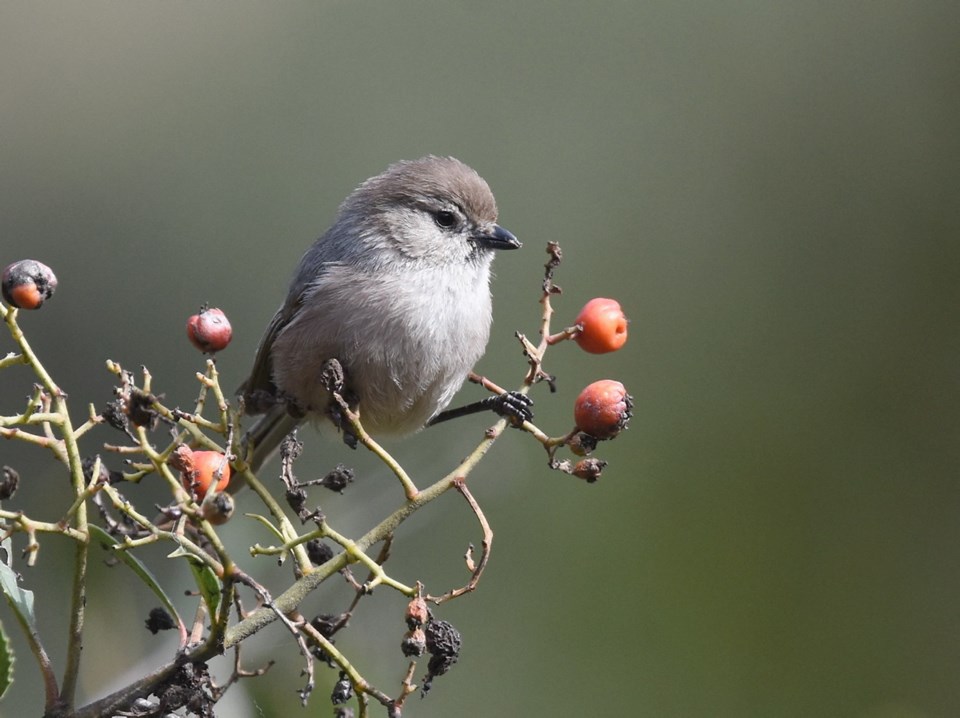Nature Boy was puzzled when I asked him why he’d thrown his sock up into the maple tree. But when I pointed the item of clothing out to him, he squealed.
“It’s a bushtit nest,” he said. “That is so cool!”
Sure enough, a teeny grey-beige bird flew up at that moment and disappeared down the top of the sock. A closer look through binoculars revealed that the “sock” was actually a long, skinny pouch woven from dried grass, old moss, lichen and hair. Dog fur? Feathers?
“Spider silk, most likely,” Nature Boy said.
It has been a fruitful spring for birdlife. A robin pair is raising a demanding brood of three right outside one of our windows. We’ve seen — and heard — a palm warbler singing his heart out in a nearby Douglas fir tree. I found a grassy nest with five round, brown-spotted eggs tucked under a shrub — explaining why a spotted towhee was freaking out nearby. An olive-sided flycatcher had a close call with our patio door. And every night through the night for the last three months, we’ve listened in on a pair of great horned owls serenading each other and their nestlings in a nearby park.
Northern flickers, downy and pileated woodpeckers, Bewick’s and Pacific wrens, golden- and white-crowned sparrows, Steller’s jays, chestnut-backed chickadees, red-breasted nuthatches, rufous and Anna’s hummingbirds…. It’s a busy spring.
Or maybe it just seems that way. Maybe we’re just noticing more this year.
With physical-distancing measures in place and many workplaces shut down or operating remotely, many of us are spending more time at home than in previous springs. With restaurants and shops closed, even those of us fortunate to still be working are spending more time outside. Child-care or homeschooling responsibilities force us out-of-doors to keep ourselves and the youngsters engaged and active. Time outside has become an absolute necessity.
We’re still worried, of course, and the stress remains, but there’s little any of us can do about it at this time.
And so, with a slower pace and smaller scope to our lives forced upon us by external events and the need to get outdoors regularly to stay sane, our daily lives open up and let the minutiae of the world around us in.
This spring, we have the time to pay attention to details we’d normally rush past. During this period of restricted mobility and options, we have the opportunity to live in higher resolution.
We might notice, for example, how maple leaves first burst forth like hands reaching toward the sky, lobe-fingers stretching up and out before taking on the familiar leaf form. We might compare the many colours, sizes and shapes of flowers on the many varieties of dogwood trees, which are now in bloom. We may perceive how shooting stars, a springtime wildflower common in local meadows, really do look like jet-powered rockets — and how their leaves recall their relation to other primroses.
We might find ourselves pausing on a walk down a nearby street to enjoy the dappled sunlight on the pavement or to admire a view we stopped looking at years ago.
We might spot the spots that give the spotted towhee its name, and see that, yes, this bird does look like a cross between a robin and a junco. We might finally get it through our noggins that a downy woodpecker’s bill is dainty and just one-third the length of the bird’s noggin, whereas a hairy woodpecker’s bill is a solid spike about as long as its head — a difference that can help us tell the two species apart. We might even notice that Nature Boy’s old wooden work sock hanging at the tops of trees is actually a nest cunningly crafted of grass, lichens and mosses.
The COVID-19 restrictions are beginning to ease. We’re taking the first tentative steps into the world’s new normal, and life will soon come rushing back in, albeit it in possibly a different form.
Until then, we can take this break from the usual noise and frenzy of modern living to pay attention to and appreciate the fine details of what the region’s natural world is sharing.
For most of us, it won’t pay the bills. But it enriches us in other ways.
- - -
To comment on this article, send a letter to the editor.
• Email: letters@timescolonist.com
• Mail: Letters to the editor, Times Colonist, 2621 Douglas St., Victoria, B.C. V8T 4M2.
Letters should be no longer than 250 words and may be edited for length, legality or clarity. Avoid emailing your letter as an attachment. Please include contact information; we require your first and last name and the municipality where you live for the letter to be considered for publication.



